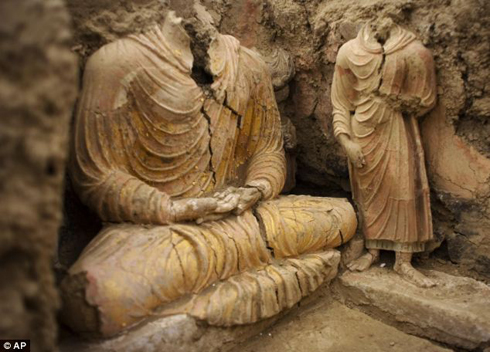
Jeff Watt, the director of Himalayan Art Resources, just brought this story to our attention.
A Chinese copper mining company in Afghanistan, the China Metallurgical Group Corp, recently unearthed an ancient Buddhist monastery that is believed to be 2,600 years old. As Watt states on his site, “The dating may be a little off but the find is certainly sensational.”
While this is undoubtedly an important and historic discovery, it should be noted that a Chinese company in war-torn Afghanistan is definitely not the safest place for two-thousand plus year-old Buddhist art. While I was happy to read that there will at least be some type of excavation and preservation effort at the site, and that it at least won’t be demolished by the Taliban like the magnificient Buddhas of Bamiyan were, it is truly a tragedy that these excavation efforts will be rushed and inadequate.

VIA dailmail.co.uk
MCC wanted to start building the mine by the end of 2011 but under an informal understanding with the Kabul government, it has given archaeologists three years for a salvage excavation. Archaeologists working on the site since May say that won’t be enough time for full preservation.
The monastery complex has been dug out, revealing hallways and rooms decorated with frescoes and filled with clay and stone statues of standing and reclining Buddhas, some as high as 10 feet.
An area that was once a courtyard is dotted with stupas standing four or 5ft high.More than 150 statues have been found so far, though many remain in place. Large ones are too heavy to be moved, and the team lacks the chemicals needed to keep small ones from disintegrating when extracted.
‘That site is so massive that it’s easily a 10-year campaign of archaeology,’ said Laura Tedesco, an archaeologist brought in by the US Embassy to work on sites in Afghanistan. ‘Three years may be enough time just to document what’s there.’Philippe Marquis, a French archaeologist advising the Afghans, said the salvage effort is piecemeal and ‘minimal’, held back by lack of funds and personnel.
The team hopes to lift some of the larger statues and shrines out before winter sets in this month, but they still haven’t procured the crane and other equipment needed.
Around 15 Afghan archaeologists, three French advisers and a few dozen labourers are working within the 0.77-square-mile area – a far smaller team than the two dozen archaeologists and 100 labourers normally needed for a site of such size and richness.
‘This is probably one of the most important points along the Silk Road,’ said Marquis. ‘What we have at this site, already in excavation, should be enough to fill the (Afghan) national museum.’
Read the complete article here.
Thank you for subscribing to Tricycle! As a nonprofit, we depend on readers like you to keep Buddhist teachings and practices widely available.